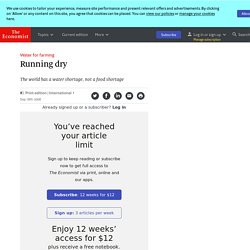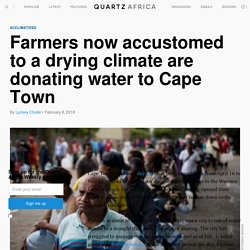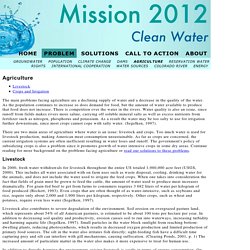

Irrigation Innovation Consortium. Running dry - Water for farming. MOST people may drink only two litres of water a day, but they consume about 3,000 if the water that goes into their food is taken into account.

The rich gulp down far more, since they tend to eat more meat, which takes far more water to produce than grains. So as the world's population grows and incomes rise, farmers will—if they use today's methods—need a great deal more water to keep everyone fed: 2,000 more cubic kilometres a year by 2030, according to the International Water Management Institute (IWMI), a research centre, or over a quarter more than they use today. Yet in many farming regions, water is scarce and likely to get scarcer as global warming worsens. The world is facing not so much a food crisis as a water crisis, argues Colin Chartres, IWMI's director-general.
Get our daily newsletter Upgrade your inbox and get our Daily Dispatch and Editor's Picks. What’s the Difference Between Water Use and Water Consumption? In January, Brian Richter, director of freshwater strategies at The Nature Conservancy, spelled out four water resolutions through a thought-provoking series of blog posts.

One of those resolutions was to better understand and communicate the differences between water use and water consumption. This is a particularly important issue, as there has been a lot of discussion lately about water scarcity, water stress, and the risks associated with them. So what do ”water use” and “water consumption” mean? $2.5M grant to help improve agricultural consumption of water, energy. Around the world, irrigated agriculture is the largest consumer of water and one of the largest users of energy.

Michigan State University scientists are leading a $2.5 million USDA National Institute of Food and Agriculture grant to better manage these resources and define more sustainable ways for irrigated agriculture to meet current and future demand for food. “Irrigated agriculture is at the core of the nexus of food, energy and water, or FEW, systems,” said David Hyndman, MSU hydrogeologist and the grant’s lead investigator. “Global change is expected to place additional pressure on these systems as U.S. climate warms and becomes more variable, and demand for food increases due to global population growth and diet shifts.” The interdisciplinary team will focus its efforts on two major irrigated regions in the U.S. and an area that has seen a rapid increase of irrigation – the High Plains, California’s Central Valley and Michigan’s Lower Peninsula, respectively.
Water, Food, and Agriculture. Agriculture uses approximately 70% of the world’s freshwater supply.

Cape Town Drought: Farmers donate water to city, as agriculture suffers — Quartz Africa. Cape Town’s ominous day zero has been moved back from April 16 to May 11, thanks to a generous donation from farmers in the Western Cape province.

On Feb. 6, farmers north of the city opened their dams to allow about 10 million liters of water to flow down to the drought-stricken city. The city is about to become the world’s first major city to run of water thanks to a drought that shows no sign of abating. The city has struggled to manage meager water sources and as of Feb. 1, water usage was forcibly reduced to 50 liters per person per day. Even as consumption is reduced, dam levels are still falling. The province’s farmers, though, have lived with the effects of climate change for several years now as annual rainfall has steadily decreased and have changed their relationship with what is now a precious resource, saving water even during wetter years. Ways to Reduce Water Consumption on Farms. One-third of the global population, the world is poised to experience even more fresh water constraints due to issues such as a growing global population, pollution, and also drought due to global climate change¹.

Just like our global energy use, we must take swift and decisive action to prevent the water wastes that are occurring around the world so that we can provide a sustainable future for future generations and the environment. Because agriculture accounts for 70% of global water resource use, and because about 60% of that water is actually wasted through runoff or evapotranspiration, the human family can make a huge impact on global freshwater supplies if we re-evaluate how we are using water in agriculture and take water conservation seriously²,³.
The following list discusses a number of ways that humanity can reduce water consumption on farms throughout the world. It is also important to grow crops that are well-suited to local climate conditions. Water Use, Withdrawal and Consumption. Sometimes the term "water use" gets, well, misused.

"Water use" often fails to adequately describe what happens to water, so when you see or hear the term you have to ask yourself what's actually being said. Water use can take two forms - consumption or withdrawal - and it's important to understand the difference between the two. In The Handbook of Water Use and Conservation, by Amy Vickers, water withdrawal is defined as "water diverted or withdrawn from a surface water or groundwater source.
" Consumptive water use, on the other hand, is defined as "water use that permanently withdraws water from its source; water that is no longer available because it has evaporated, been transpired by plants, incorporated into products or crops, consumed by people or livestock, or otherwise removed from the immediate water environment. " In the United States we withdraw a lot of water on a daily basis for our homes, businesses and food. Can We Eat Less Water? - Environment Reports. What we choose to eat inevitably affects how much water we use.

The plants we grow for crops and the animals we raise for food need a lot of water. Since croplands and pasture together cover almost all of the viable land on earth, we indirectly consume a tremendous amount of freshwater. Mission 2012 : Clean Water. The main problems facing agriculture are a declining supply of water and a decrease in the quality of the water.

As the population continues to increase so does demand for food, but the amount of water available to produce that food does not increase. There is competition over the water in the rivers. Water quality is also an issue, since runoff from fields makes rivers more saline, carrying off soluble mineral salts as well as excess nutrients from fertilizer such as nitrogen, phosphorus and potassium. As a result the water may be too salty to use for irrigation further downstream, since most crops cannot cope with salty water. (Segelken, 1997). Water use efficiency in agriculture. Based on data analysis of the agronomy subject area and its related journals and the rise in Chinese research in this field in recent years, we selected 'water use efficiency in agriculture' as a theme for this article collection, and selected the highest cited articles of more than 30 Chinese authors in recent years.

We trust that this article collection is a selection of quality articles to readers, and with the collection we hope to promote the research and progress in this field. Sustainable Irrigation Program. The Program has a strong history of reducing adverse impacts of irrigation on the environment and third parties, whilst improving water use efficiency and best practice land management for environmental and productive outcomes. The Program is administered by DELWP and is delivered in partnership with Catchment Management Authorities (CMAs), extension staff from the Department of Economic Development, Jobs, Transport and Resources (DEDJTR) and rural water corporations.
Irrigated agriculture in Victoria accounts for 38% of the state’s agricultural output, contributing $4.4 billion to the economy in 2013-14, while utilising just 3% of the state’s land area. The intensive nature of irrigation has the potential to have significant impacts at the local and catchment scale if left unmanaged. The program: The Victorian Government is investing $59.5 million over the next four years in the program. DELWP’s delivery partners are: Mallee Catchment Management Authority.
Agriculture & Irrigation » Mekong River Commission. With more than 20 per cent of the population considered to live below the poverty line, and 15 per cent undernourished, agriculture provides food security and livelihoods for approximately 60 per cent of the Mekong River Basin’s population. Mekong countries strive to develop this sector, as there is a direct correlation between increasing agricultural yield and poverty reduction. The diverse ecosystem of the Mekong River Basin means that some areas are conducive to high yields and others are limited by poor soil and water availability in the dry season.
Due to water shortages in the dry season, agricultural productivity is low throughout Cambodia and Northeast Thailand and moderate in Lao PDR, as well as in the Central highlands of Viet Nam. Viet Nam’s Delta is the only area in the basin where farmers can harvest up to seven rice crops every two years. Over 10 million hectares of cultivated land is dedicated to rice production. Sustainable Use of Water for Irrigation in Indian Agriculture on JSTOR. Capitulo6 wagriculture. 13622989291 ^$^ Jordan Agricultural Policy Paper English. High-tech agriculture can prevent oncoming global water wars. Forget about oil or gas – you should be worrying about the less discussed but far more concerning fact that the world is running out of clean, drinkable water.
I wrote this article while in Kathmandu. Nepal’s capital and largest city has a severe water shortage. Even though all homeowners pay a fee to the government to get water on tap, supplies run only once a week for a few hours. Desperate residents are then forced to purchase water from private suppliers. While this is affordable for richer people, it’s a big problem for the lower and middle classes. More than a billion people around the world have no reasonable access to fresh water.
Agricultural Irrigation System Design to Reduce Water Usage - Agricultural Tourism. In many locations around the world, the importance of irrigation in agriculture is difficult to overstate, since few regions are blessed with regular, reliable rainfall. Water Usage in Farming - Remote Water Monitoring & Leak Detection - SUMS. Agricultural water management. The FAO forecasts that by 2050 global water requirements for agriculture will increase by 50 per cent to meet the increased food demands of a growing population.
Global freshwater is becoming increasingly scarce, due to improper management, indiscriminate use and a changing climate. If 80% water consumption in India is for agriculture, why is it unregulated and inefficient? Working with suppliers & farmers to manage water use. Smallholder farmers in southern India face many challenges in trying to earn a living. Africa Country WF Profiles briefing FINAL. - The Washington Post. Legislation on Use of Water in Agriculture. I. Legal Framework A. National Legislation Argentina’s National Constitution (Constitución Nacional, CN)[1] establishes a federal form of government, setting the basis for the distribution of competencies between the central government and the provinces.[2] The provincial governments have the authority to legislate in matters related to the creation of regions for social and economic development.[3] Provinces have also been assigned specific authority to legislate on matters related to natural resources in their territories.[4] However, the central government has the authority to regulate internal river navigation and commerce as well as the setting of minimum environmental protection standards.[5]
Water Resources: Agricultural and Environmental Issues. 2007WR006331. Water Use in Agriculture RDE Strategy. Agriculture Consumes 92% of Freshwater Used Globally - US Leads Per Capita Consumption. © Hoekstra and Mekonnen/PNAS 2012. How are industries reducing their water consumption? - Locker Group. The United Nations World Water Day is held on March 22nd. Its focus: bringing to attention the importance of freshwater and its sustainable management. Each year revolves around a specific aspect of water, and this year, the theme is wastewater. Agriculture and rural development. Irrigation & Water Use. Reducing water use in agriculture. Www.forbes. I. WATER RESOURCE ISSUES AND AGRICULTURE. AQUASTAT - FAO's Information System on Water and Agriculture. Estimation of Agricultural Water Consumption from Meteorological and Yield Data: A Case Study of Hebei, North China.
170118 Study Water Agriculture India. Agriculture and Food. Water in Agriculture. Australian Academy of Technology and Engineering (ATSE) Water use in agriculture. Agricultural Water. Use of water in food and agriculture - Lenntech. Water in Agriculture. Management of water consumption in agriculture: A model for the economic optimisation of water use: application to a sub-humid area. Agricultural Water. Australian Academy of Technology and Engineering (ATSE) 1370.0 - Measures of Australia's Progress, 2010. Use of water in food and agriculture - Lenntech.